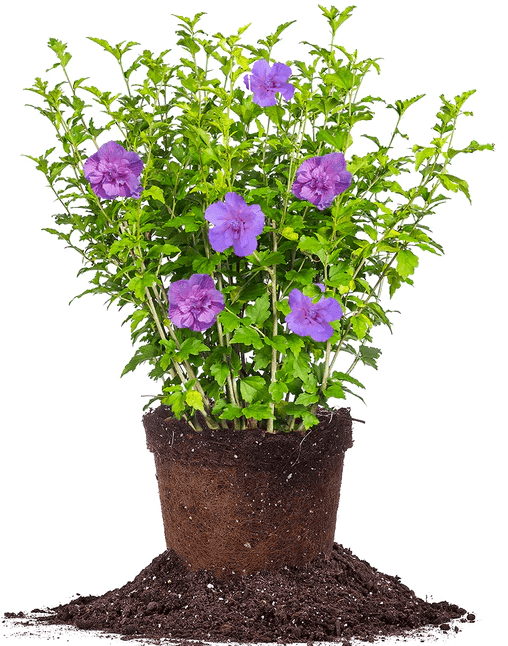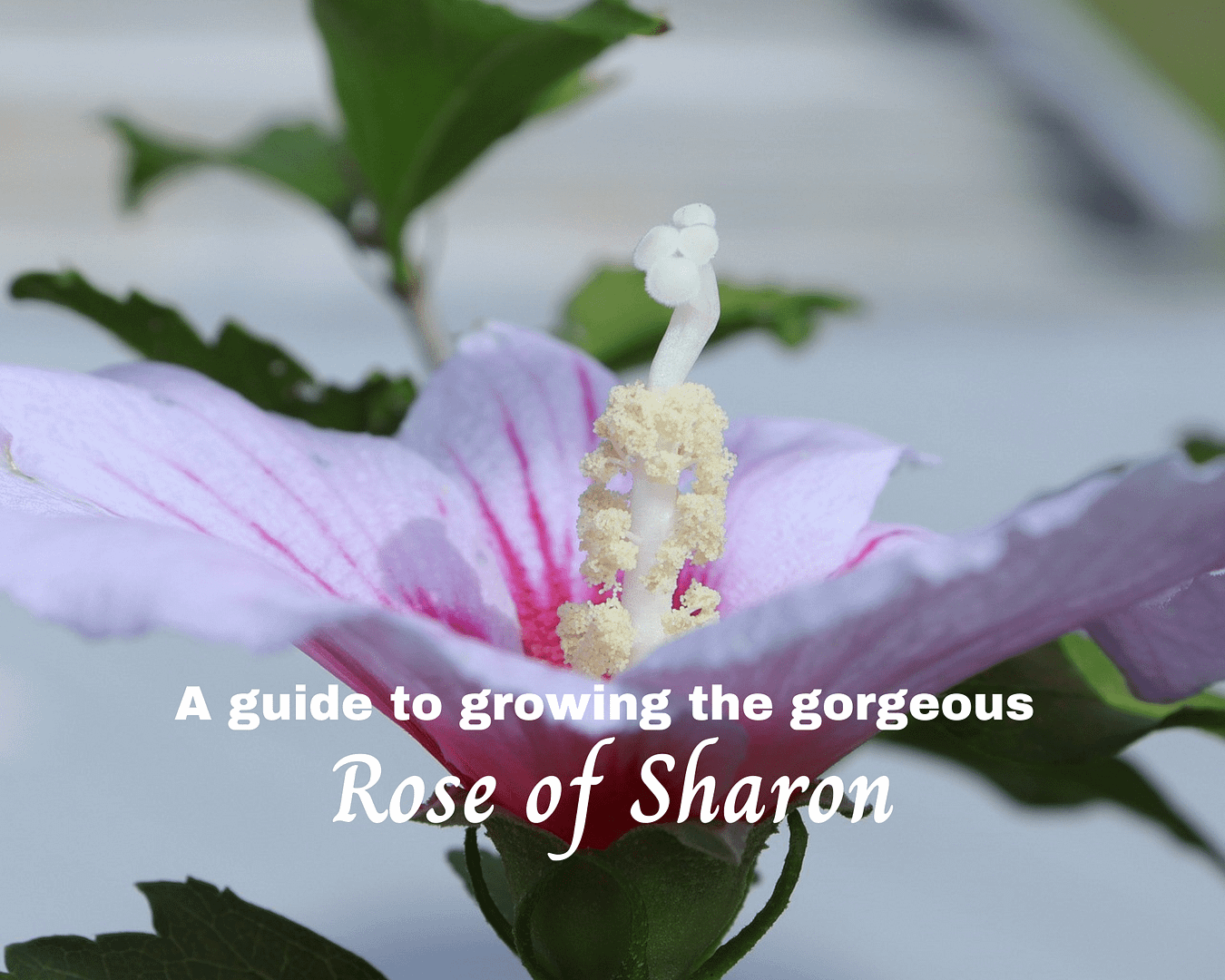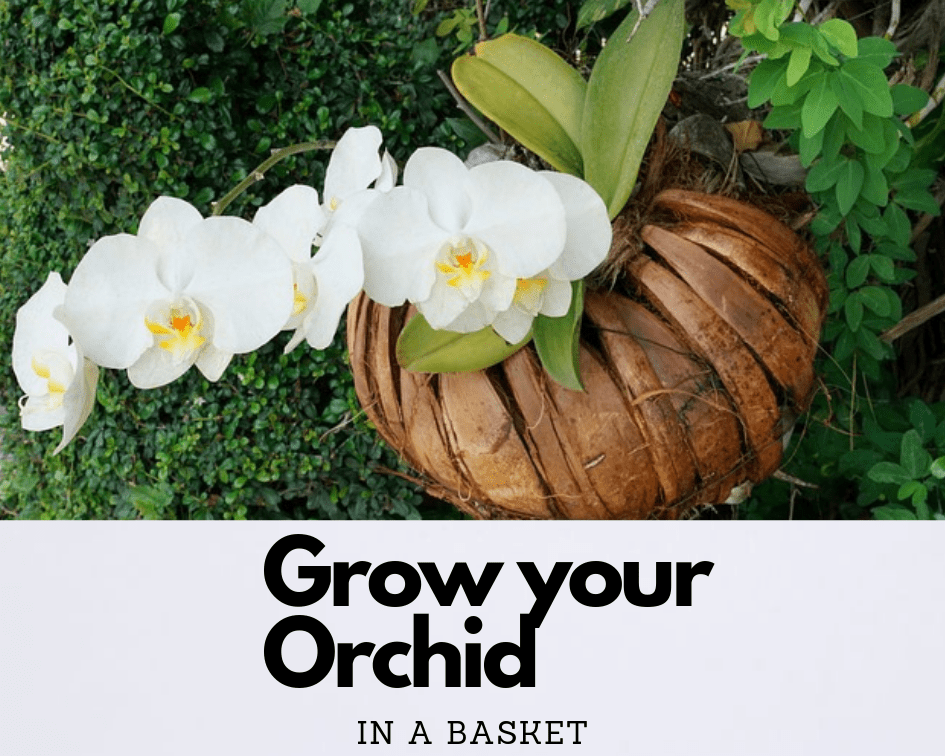This post may contain affiliate links. As an Amazon Associate we earn from qualifying purchases.
What can we say about a gorgeous lady who goes by several aliases? That would be Hibiscus syriacus, but she often goes by rose of Sharon, althea and rose mallow.
What we can say about her, to start, is that she is one amazingly beautiful shrub. She blooms through summer in shades of blue, red, purple, white, mauve, or a mixture of colors.
Today we dive into learning all we can about this gorgeous plant with tropical-looking flowers.
First, a little history
Hibiscus syriacus originally hails from India and China but was found growing in Europe by the 16th century. “By the 18th century, the shrub was common in … the American colonies,” according to Kathy Clare at DumbartonHouse.org.
In fact, “Thomas Jefferson grew Rose of Sharon from seed and planted them at all three of his houses,” she concludes.
This stunning plant has captivated gardeners and horticulturists around the world due to its eye-catching flowers, easy cultivation, and adaptability to various growing conditions.

Rose of Sharon’s preferred growing conditions
Preferred Soil: Hibiscus syriacus thrives in well-draining, loamy soil with a pH between 5.5 to 7.5. You can find a soil pH tester in the Resources section at the end of this post.
To determine if your soil is loamy, grab a handful and squeeze it. If it remains in a ball when you open your hand, yet falls apart if you poke it, congratulations! You have loamy soil.
There is help for those of us who have a different type of soil: amendments. Use organic material, such as composted manure, compost and dried leaves, to amend the bed where you hope to grow your rose of Sharon.
Spread a two-to-three-inch layer on top of the bed and use a garden fork to mix the amendment into the top six inches of soil. If you live in an area with hot, hot summers, apply a 4-inch layer (at least) of mulch over the amendment and spread to the plant’s dripline. Keep the mulch at least 6 inches from touching the plant.
Amount of Sunlight: These shrubs are sun-loving plants and require at least 6-8 hours of direct sunlight daily to produce abundant blooms. This doesn’t apply to our friends in hot climates, Morning sun and afternoon shade should be enough to keep the Hibiscus syriacus in bloom.
Cold/Heat Tolerance: Hibiscus syriacus is known for its excellent cold tolerance and can withstand temperatures as low as -15°C (5°F) once established.
On the other hand, it can handle heat reasonably well, although it may require additional watering during hot, dry spells.

How to plant Hibiscus syriacus
Planting Hibiscus syriacus is relatively straightforward. Here’s a step-by-step guide:
Choose a location: Select a spot that receives plenty of sunlight and has well-draining soil.
Dig the hole: Dig a hole twice the width of the root ball. The depth should be the same as the pot in which it is currently growing. Use a garden fork to scrape the sides of the hole to loosen the soil a bit.
Planting: Place the hibiscus in the hole, ensuring the top of the root ball is level with the soil surface. Fill the hole halfway with soil and then fill it entirely with water. Allow the water to drain and then fill the hole completely with soil. Pat the soil gently and water well. This process helps remove air pockets near the roots.
Finally, spread a 3-inch layer of mulch over the soil, surrounding but not touching the shrub.
The water needs of the rose of Sharon
Deep, consistent watering during the growing season will help the rose of Sharon produce those gorgeous flowers. Overwatering, however, can kill it. Ensure that the soil remains moist. We like to compare it to a wet but well-wrung sponge.
Remember to check the soil more frequently during hot, dry and windy weather.
How to fertilize Hibiscus syriacus
To encourage healthy growth and abundant flowering, fertilize Hibiscus syriacus with a 3:1:2 ratio fertilizer in early spring. The one we use most is 6-2-4, available at Fast Growing Trees (disregard the “evergreen” on the label. This ratio is the best for most things we plant in our gardens.)
We also recommend a 3-inch layer of aged compost on the soil around the shrub, under the mulch. Reapply each spring.
Pruning the Hibiscus syriacus
Hibiscus syriacus blooms on new wood and pruning the shrub is the way to promote that growth.
If you live in a cold-winter area, put off pruning until spring. This allows the old foliage that remains on the shrub to offer some protection during a chilly winter.
Prune instead just before the leaves pop, typically in late February. Feel free to prune it back hard, if needed. At the very least, prune out any dead or growth and branches that cross one another. Finally, don’t be afraid to shape the shrub to your tastes.
Protect the Hibiscus Syriacus in Winter
Keep in mind that Hibiscus syriacus is hardy to USDA zones 5-9. The word “hardy” describes a plant’s ability to tolerate cold and the USDA zones help growers determine if their region is too cold for a particular plant.
Don’t know your hardiness zone? Use our guide; enter your ZIP Code and out pops your zone.
In regions with harsh winters, providing some winter protection is beneficial for Hibiscus syriacus. Apply at least 4 inches of mulch around the base of the plant and spread it to the dripline to insulate the roots and protect them from freezing temperatures.
Additionally, you can wrap the shrub in burlap, use a commercial tree wrap (the easiest method) or cover it with a frost cloth to shield it from severe cold.
Common Pests and Diseases of the Rose of Sharon
While Hibiscus syriacus is generally a healthy plant, it can be susceptible to certain pests and diseases. Some common issues include:
Aphids: These tiny insects feed on the plant’s sap and can cause distorted growth. Regularly inspect the plant and use a jet of water from the hose to knock them off. Repeat the process every three days until they’re no longer a problem.
Japanese Beetles: These beetles feed on the plant’s leaves, causing skeletonized damage. The grubs live in the soil and feed on the plant’s roots. Use beneficial nematodes to get to the grubs and Bonide Japanese Beetle Killer to kill the adults. You can also try neem oil, if you prefer. Both the Bonide product and neem will kill bees so apply it in the evening when bees aren’t feeding. The two products also should be used at the first sign of an infestation for best results.
Cercospora Leaf Spot: This fungal disease causes dark spots that eventually turn yellow on the leaves. Remove affected leaves and ensure good air circulation around the plant to prevent further spread. Prevent new outbreaks by spraying the plant with a copper fungicide.
Powdery Mildew: A common fungal disease that creates a white powdery coating on the leaves. Remove infected leaves and rake up any that have fallen onto the soil. Then, spray the rose of Sharon with a fungicide, such as the one listed in the section above. Read the instructions to learn how often to apply it to prevent new infections.

Propagation of Rose of Sharon
Hibiscus syriacus can be propagated through various methods, including:
Seeds: Collect seeds from the matured seed pods in late summer or early fall. Sow them in a seed-starting mix and keep them in a warm, bright location until they germinate.
Cuttings: This is by far the easiest way to propagate this shrub. Take 3- to 6-inch-long semi-hardwood cuttings from the current season’s growth. The best time to take these cuttings is in late spring to early summer.
Allow at least two leaves to remain at the tip of the cuttings. Dip the cut ends in rooting hormone and plant them in a well-draining potting mix.
Place a humidity dome or plastic bag over the potted cutting as it plant roots. Amazon sells a 7″ tall dome which is ideal for the Hibiscus syriacus cuttings. Bottom heat, via a heat mat, might help speed things along.
A semi-hardwood cutting, by the way, is one that breaks cleanly when bent. If it doesn’t break, it’s a softwood cutting. If it breaks uneven or jagged, it’s a hardwood cutting.
Layering: In early spring, bend a lower branch of the shrub to the ground and partially bury it. After a few months, the buried portion should have developed roots, and it can be separated from the parent plant. Use a garden staple to hold it in place.
Popular Hibiscus Syriacus Cultivars
There are so many choices when it comes to choosing a Hibiscus syriacus cultivar to purchase. Here are a few of the most popular right now (see the Resources section, below, for where to purchase):
‘Blue Bird’: This cultivar stands out for its stunning, sky-blue lacy flowers. See the photo in the Resources section, below.
‘Diana’: Known for its large, pure white flowers, ‘Diana’ adds an elegant touch to any landscape. It is a vigorous grower and tends to bloom abundantly throughout the summer.
‘Aphrodite’: One of the showiest cultivars, ‘Aphrodite’ boasts large, ruffled, deep pink flowers with red centers. It is a robust and disease-resistant variety.
‘Minerva’: This cultivar features soft lavender-pink flowers with a dark red eye. It has a slightly more compact growth habit compared to other varieties.
Whichever cultivar you choose, you won’t regret growing the Hibiscus syriacus. You’ll feel like you live in the tropics every time you look at it!
Learn how to grow tropical hibiscus — we have an in-depth guide!
Resources
‘Bluebird’ Hibiscus Syriacus Live Plant
‘Diana’ Hibiscus Syriacus Live Plant
‘Aphrodite’ Hibiscus Syriacus Live Plant
‘Minerva’ Hibiscus Syriacus Live Plant





